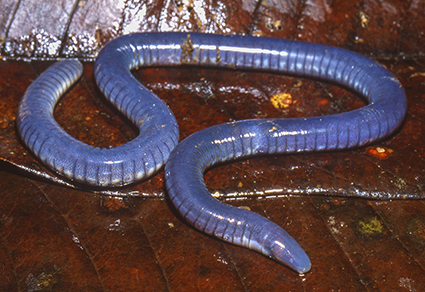Abstract
The Central portion of the Cordillera Oriental of Colombia is currently reported to harbor two species of Caecilia distributed at comparable elevations on opposite versants of these Mountains. These are C. corpulenta, known from Virolín, Santander, at 1700–2000 m on the western slopes of the Cordillera Oriental and C. degenerata, known from Garagoa, Boyacá, and Choachí and Fomequé, Cundinamarca, at 1800–2100 m on the eastern slopes of the Cordillera Oriental. Both species have dermal scales and lack secondary grooves, and have been subjected to misidentifications by herpetologists studying the Gymnophiona of the Eastern Andes of Colombia. Our results indicate that only the latter species is found in Colombia and the former is restricted to Peru, leaving those populations previously referred to C. corpulenta and those distinct from C. degenerata pending names. We here present an account for C. degenerata based on material from Choachí and Fómeque, Cundinamarca, as well as descriptions of three new species from the Cordillera Oriental and adjacent Venezuela: C. atelolepis sp. nov., C. epicrionopsoides sp. nov., and C. macrodonta sp. nov. We also provide additional morphological information for the recently described C. pulchraserrana.
References
Acevedo-Rincón, A.A., Franco, R. & Pérez, K.S. (2014) Geographic distribution: Caecilia subnigricans (Magdalena Valley Caecilian). Herpetological Review, 45 (3), 456.
Acosta-Galvis, A.R. (2012) Anfibios de los enclaves secos del área de influencia de los Montes de María y la ciénaga de La Caimanera en el Departamento de Sucre. Revista Biota Colombiana, 13 (2), 211–231.
Acosta-Galvis, A.R., Torres, M. & Pulido-Santacruz, P. (2019) A new species of Caecilia (Gymnophiona, Caeciliidae) from the Magdalena Valley region of Colombia. ZooKeys 884, 135–157. https://doi.org/10.3897/zookeys.884.35776
Arredondo-Salgar, J.C. (2007) Caecilia thompsoni (Thompson’s Caecilian). Maximum body size. Herpetological Review, 38 (4), 444–445.
Dunn, E.R. (1942) The American caecilians. Bulletin of Museum of Comparative Zoology, Harvard University, 1942, 439–540.
Exbrayat, J.-M. & Estabel, J. (2006) Anatomy with particular reference to the reproductive system. In: Exbrayat, J.-M. (Ed.), Reproductive Biology and Phylogeny of Gymnophiona (Caecilians). Science Publishers Inc., Enfield, New Hampshire, pp. 79–155.
Fernández-Roldán, J.D. & Lynch, J.D. (2021) A new species previously confused with Caecilia pachynema (Günther, 1859) (Amphibia: Gymnophiona: Caeciliidae) from the Cordillera Central of Colombia. Revista Latinoamericana de Herpetología, 4 (2), 53–64. https://doi.org/10.22201/fc.25942158e.2021.02.278
Fernández-Roldán, J.D. & Rueda-Almonacid, J.V. (2022) A new species of the genus Caecilia Linnaeus, 1758 (Amphibia: Gymnophiona: Caeciliidae) from Caquetá, Colombia. Revista Latinoamericana de Herpetología, 5 (3), 51–57. https://doi.org/10.22201/fc.25942158e.2022.3.484
Frost, D. (2021) Amphibian Species of the World: an Online Reference. Version 6.1. American Museum of Natural History, New York, New York. Electronic Database. Available from: https://amphibiansoftheworld.amnh.org/index.php (accessed 8 November 2022) https://doi.org/10.5531/db.vz.0001
Funk, W.C., Fletcher-Lazo, G., Nogales-Sornosa F. & Almeida-Reinoso, D. (2004) First description of a clutch and nest site for the genus Caecilia (Gymnophiona: Caeciliidae). Herpetological Review, 35 (2), 128–130.
Giri, V.B., Wilkinson, M. & Gower, D.J. (2003) A new species of Gegeneophis Peters (Amphibia: Gymnophiona: Caeciliidae) from southern Maharashtra, India, with a key to the species of the genus. Zootaxa, 351 (1), 1–10. https://doi.org/10.11646/zootaxa.351.1.1
Gomes, A.D., Moreira, R.G., Navas, C.A., Antoniazzi, M.M. & Jared, C. (2012) Review of the reproductive biology of caecilians (Amphibia, Gymnophiona). South American Journal of Herpetology 7 (3), 191–202. https://doi.org/10.2994/057.007.0301
Gower, D.J. & Wilkinson, M. (2005) Conservation biology of caecilian amphibians. Conservation Biology, 19 (1), 45–55. https://doi.org/10.1111/j.1523-1739.2005.00589.x
Gower, D.J., Giri, V.B., Torsekar, V.R., Gaikwad, K. & Wilkinson, M. (2013) On the taxonomic status of Gegeneophis nadkarnii Bhatta & Prashanth, 2004 (Amphibia: Gymnophiona: Indotyphlidae). Zootaxa, 3609 (2), 204–212. https://doi.org/10.11646/zootaxa.3609.2.6
Kluge, A.G. (1983) Type-specimens of amphibians in the University of Michigan Museum of Zoology. Miscellaneous Publications. Museum of Zoology, University of Michigan, 166, 1–68.
Lynch, J.D. (2000) Una aproximación a las culebras ciegas de Colombia (Amphibia: Gymnophiona). Revista de la Academia Colombiana de Ciencias Exactas, Físicas y Naturales 23 (suplemento especial), 317–337.
Maciel, A. O. & Hoogmoed, M. S. (2011) Taxonomy and distribution of caecilian amphibians (Gymnophiona) of Brazilian Amazonia, with a key to their identification. Zootaxa, 2984 (1), 1–53. https://doi.org/10.11646/zootaxa.2984.1.1
Nussbaum, R.A. & Wilkinson, M. (1989) On the classification and phylogeny of caecilians (Amphibia: Gymnophiona), a critical review. Herpetological Monographs, 3, 1–42. https://doi.org/10.2307/1466984
Péfaur, J.E., Perez, R., Sierra, N. & Godoy, F. (1987) Density reappraisal of caeciliids in the Andes of Venezuela. Journal of Herpetology, 21 (4), 335–337. https://doi.org/10.2307/1563977
Pérez, O.D., Lai, N.B., Buckley, D., del Pino, E.M. & Wake, M.H. (2009) The morphology of prehatching embryos of Caecilia orientalis (Amphibia: Gymnophiona: Caeciliidae). Journal of Morphology, 270, 1492–1502. https://doi.org/10.1002/jmor.10772
Restrepo, A., Molina-Zuluaga, C., Hurtado, J.P., Marín, C.M. & Daza, J.M. (2017) Amphibians and reptiles from two localities in the northern Andes of Colombia. Check List, 13 (4), 203–237. https://doi.org/10.15560/13.4.203
Ruiz-Carranza, P.M., Ardila, M.C. & Lynch, J.D. (1996) Lista Actualizada de la fauna Amphibia de Colombia. Revista de la Academia colombiana de Ciencias Exactas Físicas y Naturales, 20 (77), 365–415.
Savage, J.M. & Wake, M.H. (2001) Reevaluation of the status of taxa of Central American caecilians (Amphibia: Gymnophiona), with comments on their origin and evolution. Copeia, 2001 (1), 52–64. https://doi.org/10.1643/0045-8511(2001)001[0052:ROTSOT]2.0.CO;2
Taylor, E.H. (1968) The Caecilians of the World: A Taxonomic Review. University of Kansas Press, Lawrence, Kansas, 848 pp.
Taylor, E.H. (1972) Squamation in caecilian, with an atlas of scales. University of Kansas Science Bulletin, 49, 989–1164.
Taylor, E.H. (1973) A Caecilian miscellany. University of Kansas Science Bulletin, 50, 187–231. https://doi.org/10.5962/bhl.part.25759
Taylor, E.H. & Peters, J.A. (1974) The caecilians of Ecuador. University of Kansas Science Bulletin, 50, 333–346. https://doi.org/10.5962/bhl.part.25761
Wilkinson, M., San Mauro, D., Sherratt, E. & Gower, D.J. (2011) A nine-family classification of caecilians (Amphibia: Gymnophiona). Zootaxa, 2874 (1), 41–64. https://doi.org/10.11646/zootaxa.2874.1.3
Wollenberg, K.C. & Measey, G.J. (2009) Why colour in subterranean vertebrates? Exploring the evolution of colour patterns in caecilian amphibians. Journal of Evolutionary Biology, 22, 1046–1056. https://doi.org/10.1111/j.1420-9101.2009.01717.x.


